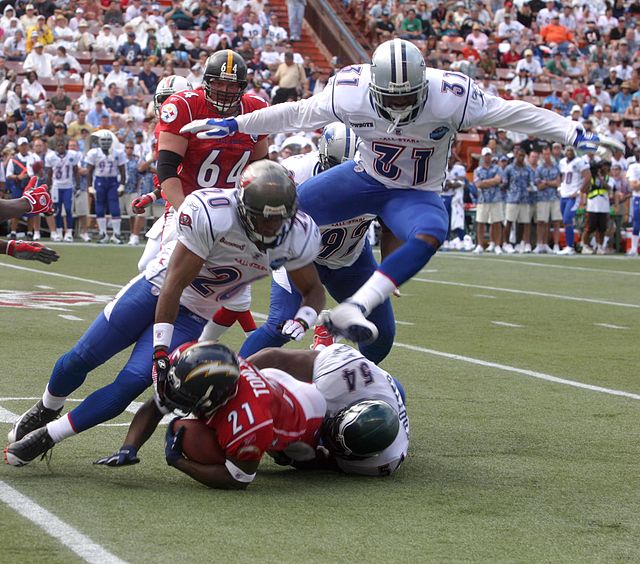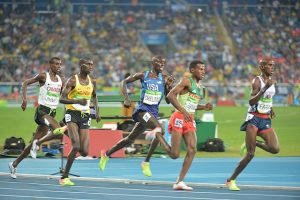Inside Quantum Technology’s Inside Scoop: Quantum and the Sports Industry

Even if you don’t watch American football, you still probably heard about the recent catastrophic injury that happened to Buffalo Bills player Damar Hamlin. I (Kenna) was actually watching it happen in real-time, shocked by the ambulance and crowd of medical staff trying to give Hamlin CPR. For those who are unfamiliar, the NFL (National Football League) recently released a statement saying that Hamlin went into cardiac arrest and had to be given CPR twice. He currently is recovering and has now been able to breathe on his own as of January 6th. The sports broadcasters and journalists covering Hamlin’s injury as it happened did their best to remain respectful and realistic, even though they too had no idea what was happening. For hours many of us waited to hear if Hamlin was even alive. Because of Hamlin’s injury, I was inspired to look further into whether quantum computing could have helped predict and prevent a similar injury to other players. My research morphed into a much broader view of how quantum computing can assist in the sports industry.
From testing the boundaries of athletic ability to creating a sense of community between fans, sports are addictive to both watch and participate in. We enjoy seeing underdog stories succeeding in real time, or having bets with our friends about which individual or team will win. As the sports industry is relying heavily on data analysis technology (such as AWS‘s AI system in American football), this suggests many potential opportunities for quantum computing to get involved. According to Statista, the worth of this industry is predicted to grow to $83.1 billion by the end of 2023, offering lucrative applications for quantum technology. There are many places that quantum can become involved, from athletic training data to betting predictions to preventing injuries. And unlike the current computing technology, quantum computing can run analyses simultaneously, offering more results in real-time for fans, coaches, referees, players, and more. These benefits also translate across multiple sports around the world, from fútbol to baseball to the Olympics, suggesting that nearly anyone in the sports industry has a potential use for quantum computing.
Starting With the Sports Industry Athlete

Runners in the 5,000 meters at the 2016 Rio Olympic games often wear fitness watches to track their times. (PC Wikimedia Commons and U.S. Army)
There are currently only a few published articles discussing quantum and sports (as I’m still following up on a few leads, I’ll be releasing a few follow-up articles to this one that are more in-depth later on). One of the most helpful articles discussing the connection between these two fields is by Dr. Benno Torgler, a professor at Queensland University of Technology. In a 2020 paper, Torgler analyzes the many different applications for quantum computing in sports, including looking at personal training data. Because most athletes (professional or amateur) don some sort of fitness watch or device, their data is being collected in real-time, such as the number of steps, blood pressure, heart rate, and more. As Torgler writes: “These digital footprints, now used intensively as exercise and training data in the field, can improve athlete’s performance, long-term health status, and These devices can give enormous amounts of data to a computer algorithm to process, which could slow down the computer and delay the results. Quantum computers, in contrast, could analyze this data with ease and even analyze the data of two or more athletes at once. This isn’t the only benefit that quantum technology can give to training data. “For example, miniaturization of quantum technologies. can promote new ways for portable sensor devices to increase their monitoring abilities, accuracy, and system integration in day-to-day usage,” explained Torgler. These devices could give even more data in real-time, offering coaches, trainers, and athletes more information in the process.
Having better training data not only gives insight into an athlete’s performance but can help coaches and trainers develop a healthier training schedule based on the data. This would be especially beneficial for younger athletes who are developing their talent. However, Torgler suggests that having too much analysis of an athlete’s data can feel intrusive and lead to possible dehumanizing behavior from coaches or trainers as they may move athletes to different teams depending on their data.
Torgler also posits that this improved data from quantum technology could extend an athlete’s career, suggesting that older athletes (who arguably have had more time growing their fanbase) could continue playing in their respective leagues. While this might sound like a benefit, it could also suggest a higher probability of developing injuries.
Predicting Injuries
Could a quantum computer have predicted Damar Hamlin’s significant injury? It’s an impossible question to answer. However, as AI is already being used to detect injuries in both the average patient and the elite athlete, it’s not hard to suggest that quantum computing might make an impact here too. As QML (quantum machine learning) algorithms combine AI with the power of quantum computing, these algorithms could potentially give faster and more in-depth analyses of an athlete’s well-being, and suggest areas that might need to be strengthened to prevent future injury. Especially in cases where an injury may flare up unexpectedly (like Hamlin’s), this analysis may not only be important but also life-saving.
Improving Sports Industry Betting and Fan Experience

Baseball is just one section of the sports industry that could be better analyzed with quantum computing (PC Wikimedia Commons and Dave Herholz)
The field of sports prediction and sports betting is an expanding one. From sports broadcasters to at-home fans, many are interested in the probability of certain plays being completed, or the data behind each play. Current computers are limited in what real-time predictions they can calculate. According to a 2016 article from the Cornell Daily Sun, classical computers are better at predicting sports like baseball, where actions happen sequentially. “The pitcher throws a pitch, the batter swings, the fielders make a play, and repeat,” the article stated. In contrast, quantum computers can run analyses simultaneously, being able to predict a wider range of sports like fútbol or American football, where there are multiple players on the field doing things at the same time. According to the article: “Players interact and make at least two or three individual decisions. keeping track of all of these things to make predictions across a few plays would overwhelm a normal computer.”
Thanks to this simultaneous analysis, referees can have a better understanding of what is happening on the field, being able to make more accurate calls on plays (to the relief of many annoyed fans). For fans, this can also give a more in-depth experience in replays of a game, but also in informing their betting decisions.
Current Collaborations
While many sports and quantum companies have yet to create any partnerships, one company is taking the lead. Germany-based Quantagonia has recently partnered with Ligalytics to create optimized match schedules for various sports leagues. As Ligalytics has been providing match schedules for major national and international sports teams for over 15 years, the company is excited to see what quantum computing can do for them. “Creating good match schedules is very complex because there are more possible schedules than there are atoms in the universe and there is always a desire to take more factors into account when creating and choosing a schedule,” said Prof. Dr. Stephan Westphal, co-founder of Ligalytics in a press release. “Our goal is to leverage quantum computing to move past the limitations of traditional computing in order to create even better schedules not computationally practical today.” Similarly, Quantagonia is also looking forward to seeing how quantum computing can make a visible impact in the sports industry. “We are very excited to be working with Ligalytics,” said Prof. Dr Sebastian Pokutta, co-founder of Quantagonia in the same press release. “Their scheduling challenges provide a great opportunity to help deliver speed and flexibility not previously possible while helping us continue to evolve our algorithms for even more performance.”
Quantum computing will no doubt change the sports industry, with more data, faster analysis, and more sensitive instruments. Depending on how much this technology is adopted by sports leagues and companies, quantum technology could become a disruptive force to the whole industry, taking the entire experience of playing and watching sports to a whole new level.
Kenna Hughes-Castleberry is a staff writer at Inside Quantum Technology and the Science Communicator at JILA (a partnership between the University of Colorado Boulder and NIST). Her writing beats include deep tech, the metaverse, and quantum technology.



















